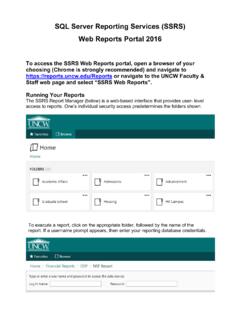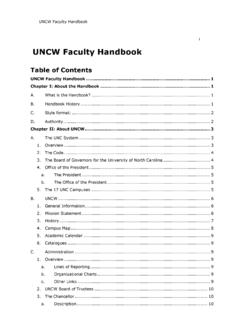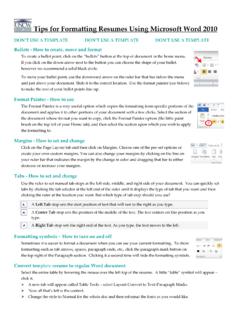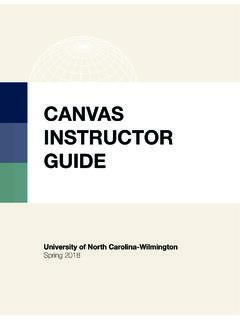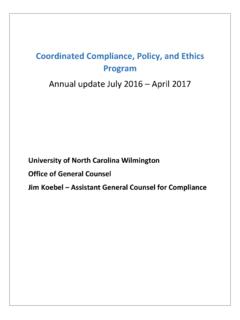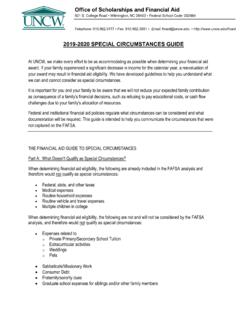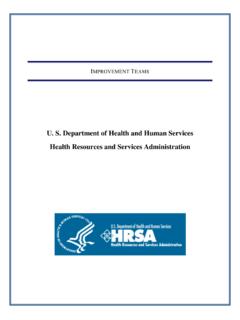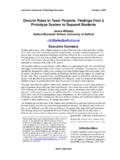Transcription of UNCW FULL CYCLE CALIBRATION GUIDE
1 UNCW FULL CYCLE . CALIBRATION GUIDE . Full CYCLE Performance CALIBRATION GUIDE Page 1. CALIBRATION Overview of CALIBRATION Process CALIBRATION sessions are the discussions that a group of supervisors has to set performance expectations and performance ratings fairly and consistently. In the performance management program, CALIBRATION sessions are held among peer supervisors in a supervisory team (that is, all supervisors who report to the same manager). As a supervisory team , you may already be doing something like this in a less formal way, or maybe you have been calling it something else. If you've had discussions about setting up work projects for the new year and assigning tasks, or setting new priorities, or adapting to new orders from above, or clarifying work rules , then you have been doing some form of CALIBRATION .
2 Goal CALIBRATION occurs at the beginning of the performance CYCLE and includes: (1) reviewing institutional goals to clarify expectations for employees in similar positions, and (2) setting individual goals for employees or employee groups that align with the strategic priorities of the work unit, the department, the School/Division, or the University. Rating CALIBRATION occurs at the end of the performance CYCLE to apply performance ratings that reflect consistent, equitable, and fair assessments of work performed across similar positions based on the expectations decided upon and communicated at the beginning of the performance CYCLE . What are Similar Positions ? Similar Positions are those in the same or similar job classifications, such as a group of Administrative Support Associates or a team of Tech Support Analysts.
3 Because employees in similar job classifications may have similar duties and performance expectations, CALIBRATION helps to ensure all of the employees, even if reporting to different supervisors within the supervisory team , are being held to the same standards and will have their work rated accordingly. Although CALIBRATION is not required for positions that are not similar, it is a best practice to discuss performance expectations across different types of positions, especially those that work together most often. In addition, some institutional goals, such as team -Oriented, apply to all employees, regardless of their job classifications, so CALIBRATION should be held to discuss consistency for those expectations. It is a recommended that supervisory teams meet periodically throughout the performance CYCLE to ensure that performance expectations are being consistently and fairly applied to all employees.
4 The Value of CALIBRATION When the CALIBRATION process is conducted in a fair manner, it encourages supervisors to think through expectations and ratings thoroughly before giving them to employees. It ensures that supervisors don't have to work alone in deciding expectations and ratings, and just knowing that they will be sharing and explaining decisions to their peers may help supervisors to think though their decision-making more carefully and conscientiously. CALIBRATION can also help supervisors: to apply similar standards to all employees Full CYCLE Performance CALIBRATION GUIDE Page 2. to use the rating scale effectively and be confident in the ratings assigned to ensure evaluations are supported by evidence of achievement to identify high performers and low performers and apply ratings appropriately to identify and correct potential rating biases or errors to highlight the accomplishments, strengths, and development needs of their employees to give feedback on performance of other employees who work regularly with their team to explain to their employees the rationale for their expectations and evaluations to discuss expectations and evaluations in a similar way with each employee to have more productive and on-going performance discussions with their employees.
5 Even when a difficult conversation is necessary Setting similar standards Ratings for employees at the end of the CYCLE are based on the performance expectations set at the beginning of the performance CYCLE . The supervisory team needs to agree on the performance level needed to meet business needs. This helps to ensure that the standards used to rate performance are balanced across the organization for identifying poor performers, successful performers, and exceptional performers. The goal is to enable performance evaluations to be carried out in a fairer and more consistent way and to eliminate the issue of one supervisor's easy rating system versus another being a tough rater. It is expected that, through discussion within the supervisor team , any supervisors who tend to give overly high evaluations and any who tend to give overly low evaluations will learn to rate their employees more fairly and consistently going forward and in alignment with the rest of the team .
6 Not a quota system The University's rating system is not a forced distribution or quota system. These are ratings systems where only certain number of people can get certain ratings (for example, in a team of eight people, there could be a requirement that only two employees can get exceeding, four get meeting, and two must get not meeting). The University is not using a system like this. In the University's performance management program, each employee is rated on performance expectations based on the business needs of the organizational unit. So, it is possible that many employees on a team might receive ratings of exceeding expectations, and it is also possible many employees on a team might receive ratings of meeting expectations, or not meeting expectations, depending how their individual performance compares to the define business needs and performance expectations.
7 How employee comparisons can be used Although employees are not competing against each other for rank in our program, supervisors can compare employees to each other during the CALIBRATION conversation. This can help supervisors see the differences in outcomes between high performers and low performers to determine if those differences also mean different ratings. Full CYCLE Performance CALIBRATION GUIDE Page 3. The Value of (Re) CALIBRATION With this new program and with these CALIBRATION conversations, supervisors might discover that they have held their employees to different standards than other supervisors have set for their employees, that they have set the bar too high or too low for their employees, or that there are new performance expectations that they have never used in past evaluations. That's okay. Because this new program is redefining how we approach performance expectations and evaluations, this is a great opportunity for management teams to rethink what the performance expectations need to be going forward based on current business needs and strategic priorities.
8 It's okay if the expectations need to change. What's important is: (1) that the management team agrees on those new expectations at the beginning of the CYCLE ;. (2) that supervisors communicate these new expectations to their employees at the beginning of the performance CYCLE so that the employees have the opportunity to adjust to them and be able to demonstrate them throughout the CYCLE ; and (3) that the management team rates employees consistently based on those expectations and the end of the CYCLE . When communicating these changes to employees, it is important to acknowledge that either the expectations have changed, so the same level of work may not equal the same ratings received previously, or that some expectations that haven't been emphasized or enforced in the past will need to be going forward. These conversations are easier to hold once the supervisory team is in agreement on what is important and what meets the business needs.
9 Tips for a Successful CALIBRATION Process Facilitator Responsibilities. Generally, the manager of the supervisory team should be the facilitator for the conversation. The facilitator should: o Set the rules . Review the process that the team will follow and hold the team accountable to the established ground rules . o Keep the discussion focused. It is easy to get side-tracked on specific or unique situations that have occurred or could occur, and this could derail the conversation into unnecessary details or on issues that aren't relevant to this meeting's purpose. The facilitator may need to table some conversations for another time, or have one-on-one meetings later to address specific concerns of individuals. o Ensure input. Some highly outspoken supervisors may try to dominate the conversation or impose their way of doing things, right or wrong.
10 The facilitator needs to get all voices in the conversation so that all perspectives can be heard. o Facilitate more than decide. Although the facilitator may provide input, they should be selective when doing so during the discussion. Their most important role is as a facilitator to get the ideas on the table, then serve as a decision-maker once the conversation is over. Full CYCLE Performance CALIBRATION GUIDE Page 4. Ground rules for Participants o Approach the CALIBRATION conversation as a management team . This isn't a competition to see who has the best employees or worst employees or who is the best or worst supervisor. The goal is to get on the same page about how you describe strong performers and weak performers so that you can be consistent as a supervisory team . Employees will notice if you each are setting different standards, which weakens your success as a team .
